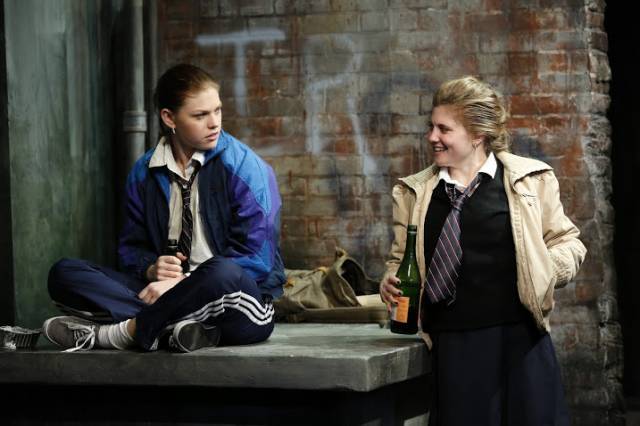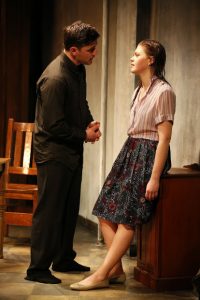

Before the Irish Rep’s production of The Belle of Belfast begins, projections of Belfast during the Irish Troubles are projected onto a brick wall. Most of the photos are of friends posing and citizens going about their day. Interspersed among them, however, are photos of explosions, dead/wounded bodies, and bombed out buildings. The play takes place in 1985, during the height of the Troubles, or the Northern Ireland conflict. The loyalists, who were mostly Protestant, wanted Northern Ireland (where Belfast is located) to remain with the U.K. The Republicans, mostly Catholic, wanted Northern Ireland to be independent of the United Kingdom. This essentially caused a war between the two countries that wouldn’t end until over a decade after the play takes place.
Growing up in this tumultuous period of U.K. history is Anne Malloy (Kate Lydic), a young woman living with her great aunt Emma Malloy (Patricia Conolly). Orphaned by an explosion that killed her parents, her faith in both her religion and her country is shaken. She is strongly attracted to Ben Reilly (the handsome Hamish Allan-Headley), a priest who rebuffs her advances due to his vow of chastity. But like the imminent explosions of terrorist bombs, their attraction has the ability to unexpectedly explode at any second.
The concept of a priest debating his human desire and religious devotion has been done before in stories such as Colleen McCullough’s The Thorn Birds. Nate Rufus Edleman’s play takes a much more intimate and tender look at the subject. Rather than exploiting the subject, it explores how a group of people deal with crises of faith and youth in times of trouble. Anne’s innocent and lovelorn best friend Ciara is trying to make sense of the violence occurring around her. Dermott, a fellow priest, admits to drinking and swearing like a sailor, but still refuses to give up the cloth. Anne’s great aunt Emma is so worried about being a sinner that she believes just observing a sin and not doing anything about it is a one-way ticket to Hell.

Under the solid, sure-handed direction of Claudia Weill, each of these characters are given solid portrayals. Kate Lydic brings out Anne’s charm and passion, but also her bitterness and rage at the death of her parents. She is extremely believable as someone who uses drugs and sex to escape the confused and confusing world she lives in. This very intelligent young woman knows the frightening past, and the potentially terrifying possibilities of the present and future. Arielle Hoffman is touching as the shy, yet secretly strong Ciara. Billy Meleady is a hoot as the hypocritical Dermott, and Patricia Conolly is touching as the dotty Emma Malloy.
While some knowledge of the Irish Troubles is certainly useful in understanding the historic context of the play, it’s not required that the viewer be an expert in the events. If anything, the Troubles are more of a backdrop to Anne’s coming of age, similar to John McDermott’s appropriately gloomy set (complete with faded bricks and barbed wire). Another strength of the play is that it doesn’t bang you over the head with history either—it smartly focuses on the characters and their reactions to the events going on around them. While the play’s conclusion is somewhat dulled by leaving a few character motivations unexplained, it is nonetheless a poignant exploration of how political, religious and social turmoil can cause crises in both youth and faith.